The eye-catching building next door but one to these premises is Oxford University’s history faculty. It was originally the city’s High School for Boys, which opened in 1881. The comic actor Ronnie Barker was a former pupil and later one of the Two Ronnies. Probably their best-known sketch was ‘Four Candles’. Barker walks into a hardware store and asks for and gets ‘four candles’. However, he really wanted fork handles – ‘andles for forks’.
Photographs and text about The Four Candles.
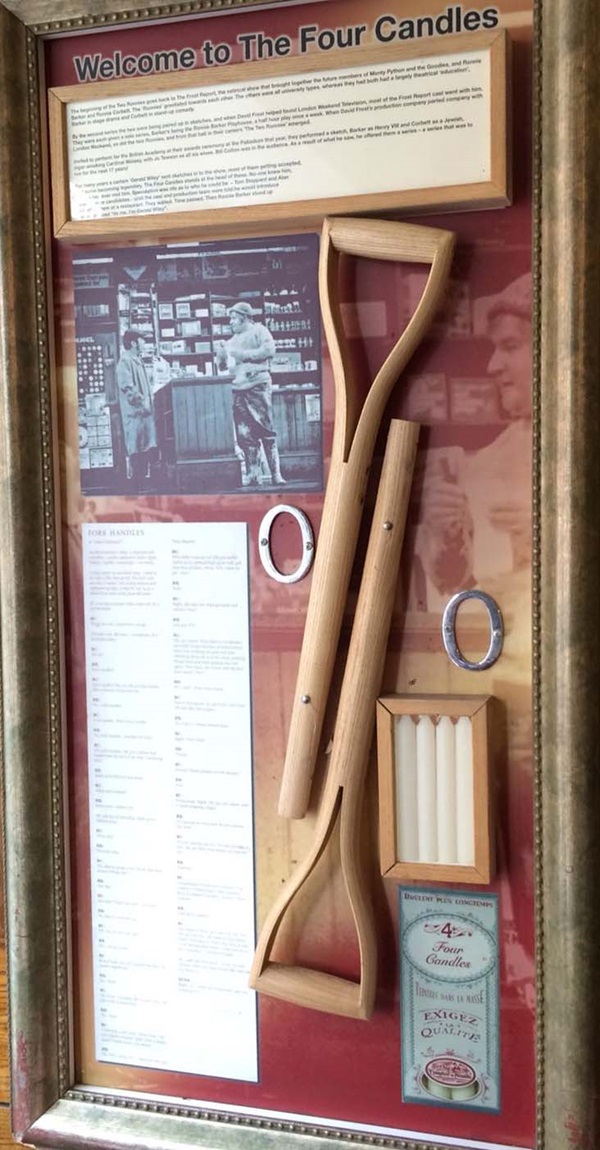
The text reads: The beginning of the Two Ronnies goes back to The Frost Report, the satirical show that brought together the future members of Monty Python and the Goodies, and Ronnie Barker and Ronnie Corbett. The ‘Ronnies’ gravitated towards each other. The others were all university types, whereas they both had a largely theatrical ‘education’, Barker in stage drama and Corbett in stand-up comedy.
By the second series the two were being paired up in sketches, and when David Frost helped found London Weekend Television, most of the Frost Report cast went with him. They were each given a solo series, Barker’s being the Ronnie Barker Playhouse, a half hour play once a week. When David Frost’s production company parted company with London Weekend, so did the two Ronnies, and from that halt in their careers The Two Ronnies emerged.
Invited to perform for the British Academy at their awards ceremony at the Palladium that year, they performed a sketch, Barker as Henry VIII and Corbett as a Jewish, cigar-smoking Cardinal Wolsey, with Jo Tewson as all six wives. Bill Cotton was in the audience. As a result of what he saw, he offered them a series – a series that was to run for the next 17 years!
For many years a certain ‘Gerald Wiley’ sent sketches in to the show, most of them getting accepted, and some becoming legendary. The Four Candles stands at the head of these. No one knew him, no one had ever met him. Speculation was rife as to who he could be – Tom Stoppard and Alan Bennett were candidates – until the cast and production team were told he would introduce himself to them at a restaurant. They waited. Time passed. Then Ronnie Barker stood up and announced “it’s me, I’m Gerald Wiley”.
Photographs and text about Felicia Skene.
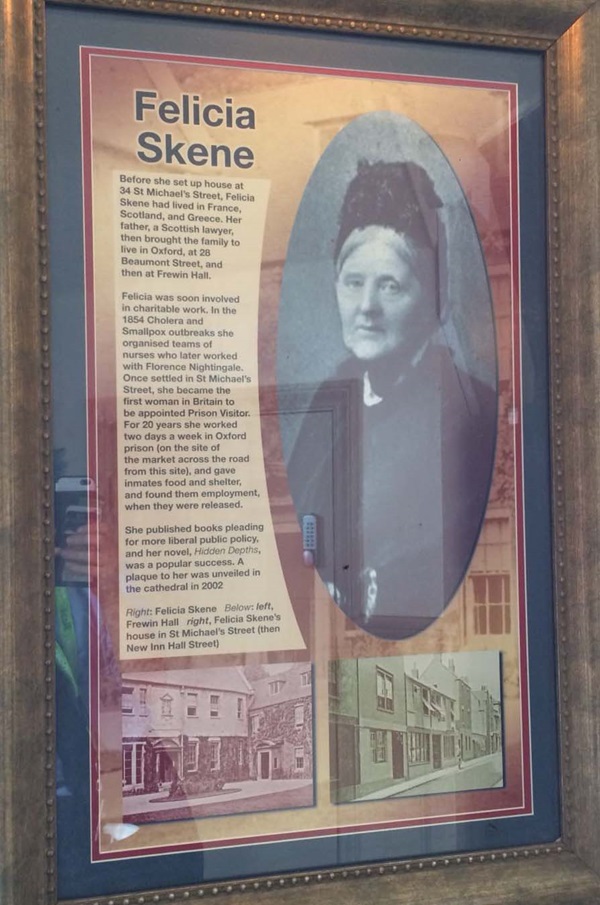
The text reads: Before she set up house at 34 St Michael’s Street, Felicia Skene had lived in France, Scotland, and Greece. Her father, a Scottish lawyer, then brought the family to live in Oxford, at 28 Beaumont Street, and then at Frewin Hall.
Felicia was soon involved in charitable work. In the 1854 Cholera and Smallpox outbreaks she organised teams of nurses who later worked with Florence Nightingale. Once settled in St Michael’s Street, she became the first woman in Britain to be appointed Prison Visitor. For 20 years she worked two days a week in Oxford prison (on the site of the market across the road from this site), and gave inmates food and shelter, and found them employment, when they were released.
She published books pleading for more liberal public policy, and her novel, Hidden Depths, was a popular success. A plaque to her was unveiled in the cathedral in 2002.
Right: Felicia Skene Below: left, Frewin Hall right, Felicia Skene’s house in St Michael’s Street (then New Inn Hall Street).
Prints and text about Thomas Hill Green.
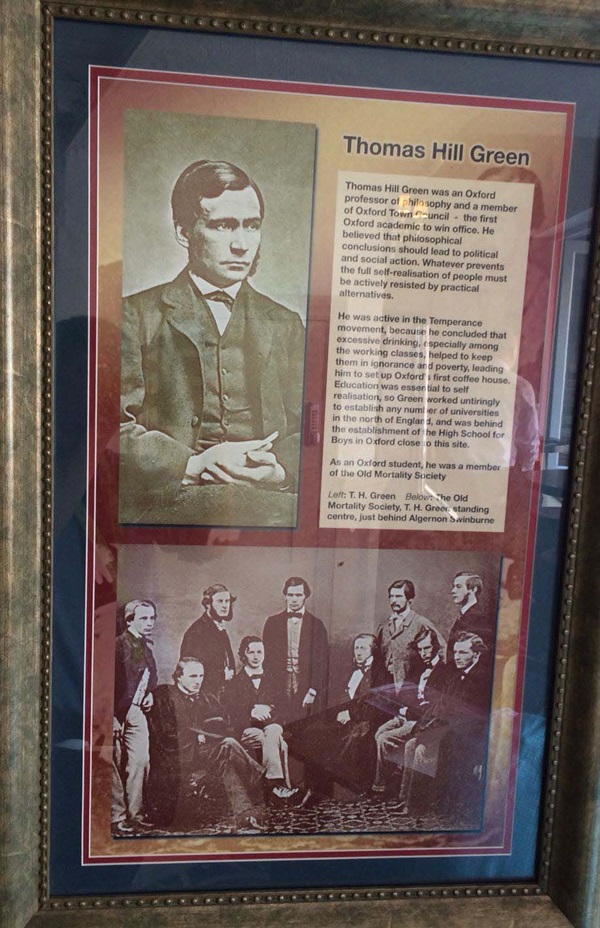
The text reads: Thomas Hill Green was an Oxford professor of philosophy and a member of Oxford Town Council – the first Oxford academic to win office. He believed that philosophical conclusions should lead to political and social action. Whatever prevents the full self-realisation of people must be actively resisted by practical alternatives.
He was active in the Temperance movement, because he concluded that excessive drinking, especially among the working classes, helped to keep them in ignorance and poverty, leading him to set up Oxford’s first coffee house. Education was essential to self-realisation, so Green worked untiringly to establish any number of universities in the north of England, and was behind the establishment of the High School for Boys in Oxford close to this site.
As an Oxford student, he was a member of the Old Mortality Society.
Left: TH Green
Below: The Old Mortality Society, TH Green standing centre, behind Algernon Swinburne.
A photograph and text about the old High School for Boys.
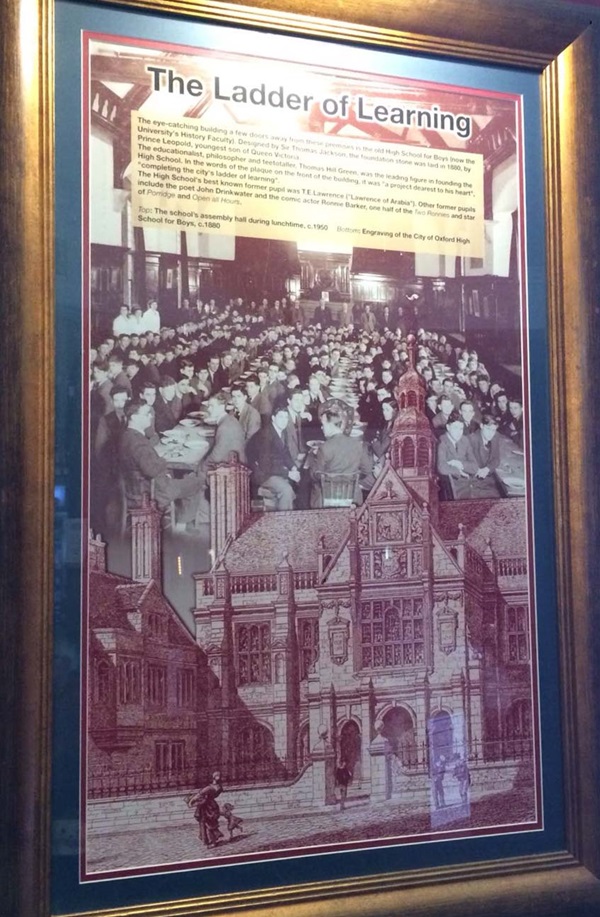
The text reads: The eye-catching building a few doors away from these premises is the old High School for Boys (now the University’s History Faculty). Designed by Sir Thomas Jackson, the foundation stone was laid in 1880, by Prince Leopold, youngest son of Queen Victoria.
The educationalist, philosopher and teetotaller, Thomas Hill Green, was the leading figure in founding the High School. In the words of the plaque on the front of the building, it was a “project dearest to his heart”, “completing the city’s ladder of learning”.
The High School’s best known former pupil was TE Lawrence (Lawrence of Arabia). Other former pupils include the poet John Drinkwater and the comic actor Ronnie Barker, one half of the Two Ronnies and star of Porridge and Open All Hours.
Top: The school’s assembly hall during lunchtime, c1950
Bottom: Engraving of the City of Oxford High School for Boys, c1880.
Illustrations and text about Bishop Trellick.
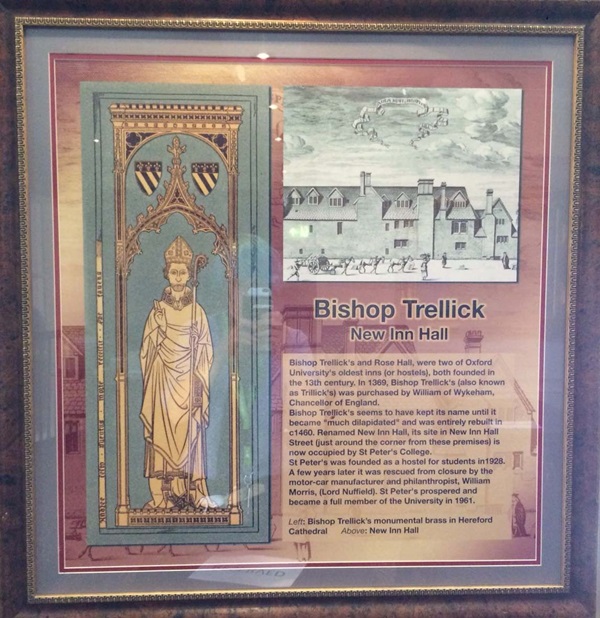
The text reads: Bishop Trellick’s and Rose Hall, were two of Oxford University’s oldest inns (or hostels), both founded in the 13th century. In 1369, Bishop Trellick’s (also known as Trillick’s) was purchased by William of Wykeham, chancellor of England.
Bishop Trellick’s seems to have kept its name until it became “much dilapidated” and was entirely rebuilt in c1460. Renamed New Inn Hall, its site in New Inn Hall Street (just around the corner from these premises) is now occupied by St Peter’s College.
St Peter’s was founded as a hostel for students in 1928. A few years later it was rescued from closure by the motor-car manufacturer and philanthropist, William Morris, (Lord Nutfield). St Peter’s prospered and became a full member of the University in 1961.
Left: Bishop Trellick’s monumental brass in Hereford Cathedral
Above: New Inn Hall.
Photographs and text about Lawrence of Arabia.
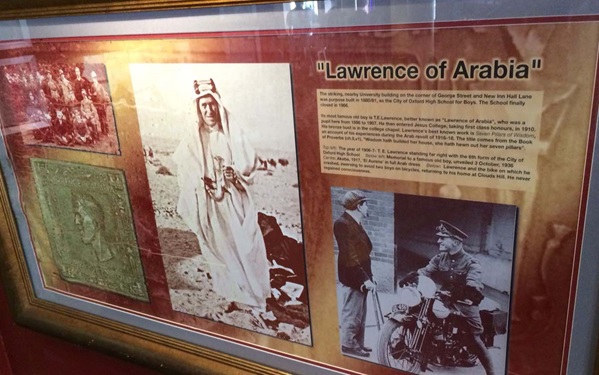
The text reads: The striking, nearby university building on the corner of George Street and New Inn Hall Lane was purpose built in 1880/81, as the City of Oxford High School for Boys. The School finally closed in 1966.
Its most famous old boy is TE Lawrence, better known as Lawrence of Arabia, who was a pupil here from 1896 to 1907. He then entered Jesus College, taking first class honours, in 1910. His bronze bust is in the college chapel. Lawrence’s best known work is Seven Pillars of Wisdom, an account of his experiences during the Arab revolt of 1916-18. The title comes from the Book of Proverbs (ch.9,v1), “Wisdom hath builded her house, she hath hewn out her seven pillars.”
Top left: The year 1906-7 TE Lawrence standing far right with the 6th form of the City of Oxford High School
Below left: Memorial to a famous old boy, unveiled 3 October, 1936.
Centre: Akaba, 1917, ‘El Aurens’ in full Arab dress
Below: Lawrence and the bike on which he crashed, swerving to avoid two boys on bicycles, returning to his home at Clouds Hill. He never regained consciousness.
Old photographs of Oxford.
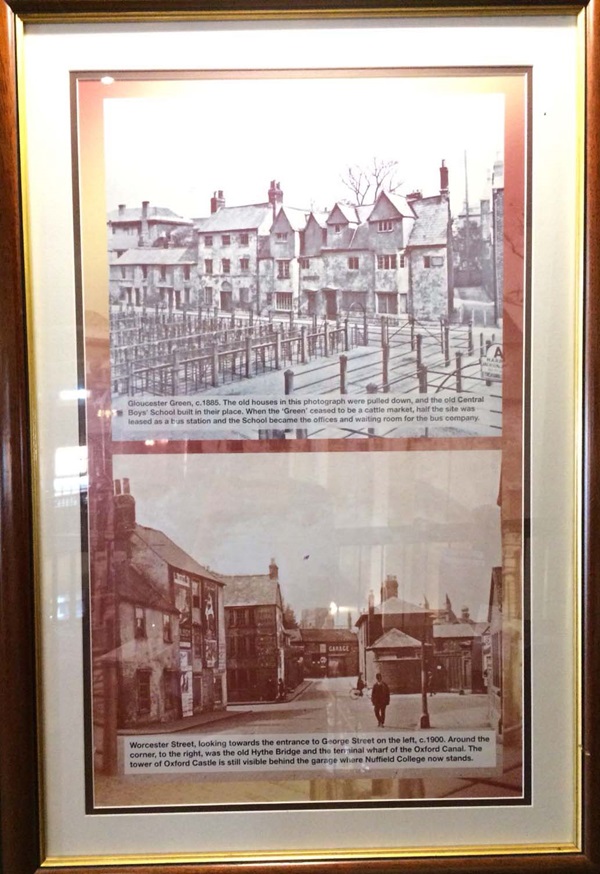
Top: Gloucester Green, c1185. The old houses in this photograph were pulled down, and the old Central Boys’ School built in their place. When the ‘Green’ ceased to be a cattle market, half the site was leased as a bus station and the School became the offices and waiting room for the bus company.
Bottom: Worcester Street. Looking towards the entrance to George Street on the left, c1900. Around the corner, to the right, was the old Hythe Bridge and the terminal wharf of the Oxford Canal. The tower of Oxford Castle is still visible behind the garage where Nuffield College now stands.
External photograph of the building – main entrance.
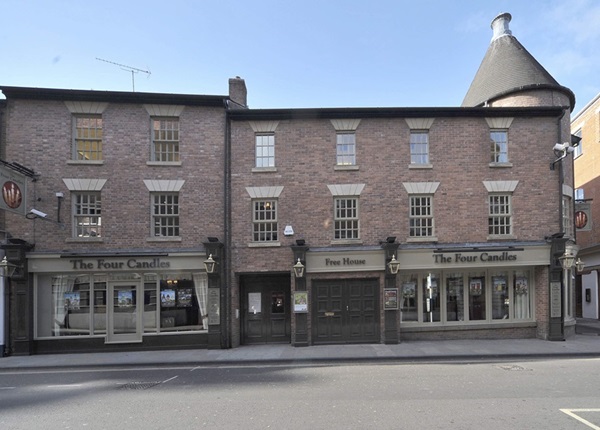
If you have information on the history of this pub, then we’d like you to share it with us. Please e-mail all information to: pubhistories@jdwetherspoon.co.uk